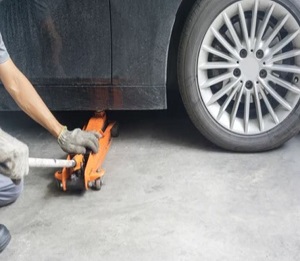
Because cars are heavy, utilizing a floor jack without caution might result in injury or damage. Using a floor jack to make minor repairs or changes may save you a lot of money. If utilized correctly, you may prevent injuring yourself or your car and take advantage of the various possibilities for house repair.
Step by step guide to jack up a car
Follow this step-by-step guide to efficiently jacking up a car with a floor jack.
Position the jack
The jack should be positioned beneath the car section that it will touch when it is lifted. When employing jack stands, put them close to the jack. You risk damaging your vehicle if you don’t use a proper jacking method. Check your vehicle’s owner’s handbook to see where the jack should be placed. The service staff at your dealership should assist you if you do not have a manual.
Lift the car
The next thing you would want now is to raise the car with the help of the jack. If you are using a scissor jack, insert the rod or wrench over the knob of the scissor jack and crank. To use a hydraulic jack, just pump up and down while holding the handle in the desired area. Take the jack handle from its lowest position to its highest point on each stroke to reduce the time and effort it takes to complete the task.
Place the jack stands
The jack stands should be placed beneath the car, close where the jack is contacting it. Raise and secure the shelves, which are just high enough to fit below. Using the jack stands as a guide, lower your car onto the jack stands.
It’s hazardous to use anything other than jack stands in place of them. They might fall out or shatter while you’re below the vehicle. In an emergency, jack stands may lift the car off the ground.
Wiggle the car
Make sure the jack stands are secure by wriggling the car a little. If the wheels are adequately blocked by wriggling, the vehicle should crash with all four wheels on the ground instead of just two.
Lower the car
The car may now be lowered to the ground by removing the supports and replacing the jack.
It’s simple: Turn the crank in the other way if you have a scissor jack. You may use the rod to turn the pressure release valve on a hydraulic jack. All you have to do now is let the jack do its thing.
Useful Tips
To maximize the use of your floor jack, here are some extra suggestions to keep you safe when using it.
- Floor jacks come in various shapes and sizes, and your car’s dealer will be able to tell you which one is ideal for your vehicle.
- Use bricks, cement blocks, or scrap wood as an alternative to wheel chocks if you don’t have any.
- You should use your floor jack on a flat surface. Your floor jack will become unstable when you elevate your car on soil or another softcover.
- If you need to raise the car, stick to using floor jacks alone. Floor jacks may be damaged if used to keep a vehicle in place.
- Always utilize a jack stand while working beneath a car. To maintain the vehicle in place, jack stands are used in conjunction with floor jacks.
- You can check for stability by giving your car a moderate nudge once it’s been jacked up. Then you may begin working on the ground level.
- Craftsman Jack Stands Review - October 18, 2022
- OTC 1545 Motorcycle Lift Review - October 18, 2022
- Pro Lift Jack Stand Review - October 17, 2022
